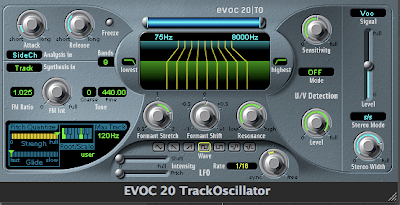 Vocoders were first developed as a means of encrypted radio transmission in the 1930's. The idea was that instead of sending actual audio, the military could send envelope shapes for a bandpass filter. You wouldn't hear anything until the receiver assigned a carrier wave of some sort to these filter envelopes after which you'd hear the familiar, robotic-sounding speaking. This method never really took off for it's original purpose, but later fell into favor with electronic musicians who found they could create mechanized singing by using musical instruments as the carrier. Apple's Logic happens to come with a vocoder called the EVOC 20 TrackOscillator. At its default setting, it uses an internal oscillator to track the pitch of a signal and vocoders that with whatever track it is assigned to. This can be fun to play with, but honestly I think the pitch tracking sounds like crap. The good news is, you don't have to use it this way, and it's actually a pretty nice sounding vocoder when you use your own signals.
Vocoders were first developed as a means of encrypted radio transmission in the 1930's. The idea was that instead of sending actual audio, the military could send envelope shapes for a bandpass filter. You wouldn't hear anything until the receiver assigned a carrier wave of some sort to these filter envelopes after which you'd hear the familiar, robotic-sounding speaking. This method never really took off for it's original purpose, but later fell into favor with electronic musicians who found they could create mechanized singing by using musical instruments as the carrier. Apple's Logic happens to come with a vocoder called the EVOC 20 TrackOscillator. At its default setting, it uses an internal oscillator to track the pitch of a signal and vocoders that with whatever track it is assigned to. This can be fun to play with, but honestly I think the pitch tracking sounds like crap. The good news is, you don't have to use it this way, and it's actually a pretty nice sounding vocoder when you use your own signals. 1. First, record a little speech. It doesn't matter what it is, but let's be honest, it's probably going to be "Domo Arigato Mr. Roboto" because you're a dork like that. It's a good idea to compress the vocal. Once you have done that, we want to assign a SEND to BUS 1. Go ahead and dial it up to 100%. Finally, change the OUTPUT of your audio channel to "NO OUTPUT". We don't actually want to hear this channel, we just want to use it to shaper the filters of the vocoder. Do the same for the OUTPUT of BUS 1.
2. Next, create a new SOFTWARE INSTRUMENT and assign it to whatever softsynth you like to make pads with. Your choice of synths and sounds here is important, because this will determine the timbre of the vocoded signal. Brighter sounds are generally preferable here. Sampled choirs sound great, as do string sounds. You may also want to adjust your amplitude envelopes to have a fast attack and short release so the notes are distinct from one another in a chord progression.
3. Assign an instance of EVOC-TO as an INSERT EFFECT on the channel of your softsynth. Go ahead and open up the EVOC-TO to access its controls.
4. Go to the SIDECHAIN dropdown menu in the upper righthand corner of the EVOC-TO window. Select BUS 1.
5. Now, look over on the lefthand side of the EVOC-20's controls and you will see dropdown menus for assigning the ANALYSIS IN (the signal being used to alter the bandpass filters), and the SYNTHESIS IN (the carrier). Set ANALYSIS IN to SIDE CHAIN and SYNTHESIS IN to TRACK.
6. Make sure to set the LEVEL to FULL and that the SIGNAL is set to VOC. Now hit play on the transport, play some sustained notes, and enjoy the robot-y goodness. Increase the number of filter BANDS to 20 for better intelligibility.
Now, I could tell you what all the other controls in EVOC-20 do, but playing with a vocoder is incredibly fun, and you'll probably understand it more on your own just by tweaking the different controls to see how it changes the results. So have some fun and next time, we'll look at some of the less traditional stuff you can do with EVOC-20.




















1 comment:
"Domo Arigato Mr. Roboto"
i lol. it's too funny and too true.although my first vocoder cheese was saying kraftwerk cheese;)
Post a Comment